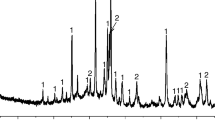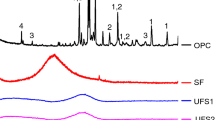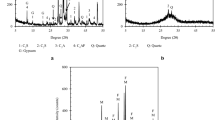Abstract
This study investigated hydration mechanism of composite binders containing blast furnace ferronickel slag at different curing temperatures. Different levels of cement replacement (15, 30, and 45% by mass) and curing temperatures (25 and 60 °C) were set. In addition to pure cement, a composite binder containing quartz with a particle size distribution similar to ferronickel slag was selected as the control sample. The results reveal that blast furnace ferronickel slag can show the pozzolanic reactivity at an early stage at room temperature despite low activity, and an early high curing temperature can improve the activity significantly. The influence of high curing temperature on the pozzolanic reaction is greater than the influence of high curing temperature on cement hydration at an early stage, and as a result, the Ca(OH)2 content in the cementitious system is lowered. However, the influence on the pozzolanic reaction is not obvious in the later stage. The high curing temperature does not change the type of hydration product but increases the content of the C–S–H gel, resulting in a significantly higher Ca–Si ratio and a slightly lower Al–Si ratio. In addition, the high curing temperature improves the early compressive strength of the concrete containing blast furnace ferronickel slag and reduces later compressive strength. A suitable dosage of blast furnace ferronickel slag may improve the resistance to chloride ion penetration of concrete at a high curing temperature.













Similar content being viewed by others
References
Snellings R, Mertens G, Elsen J. Supplementary Cementitious Materials. Rev Mineral Geochem. 2012;74:211–78.
Damtoft JS, Lukasik J, Herfort D, Sorrentino D, Gartner EM. Sustainable development and climate change initiatives. Cem Concr Res. 2008;38:115–27.
Juenger MCG, Winnefeld F, Provis JL, Ideker JH. Advances in alternative cementitious binders. Cem Concr Res. 2011;41:1232–43.
Lothenbach B, Scrivener K, Hooton RD. Supplementary cementitious materials. Cem Concr Res. 2011;41:1244–56.
Liu SH, Kong YN, Wang L. A comparison of hydration properties of cement-low quality fly ash binder and cement–limestone powder binder. J Therm Anal Calorim. 2014;116:937–43.
Wang AQ, Zhang CZ, Sun W. Fly ash effects: II. The active effect of fly ash. Cem Concr Res. 2004;34:2057–60.
Yan PY, Mi GD, Wang Q. A comparison of early hydration properties of cement–steel slag binder and cement–limestone powder binder. J Therm Anal Calorim. 2014;115:193–200.
Gruyaert E, Robeyst N, Belie ND. Study of the hydration of Portland cement blended with blast-furnace slag by calorimetry and thermogravimetry. J Therm Anal Calorim. 2010;102:941–51.
Feng JJ, Liu SH, Wang ZG. Effects of ultrafine fly ash on the properties of high-strength concrete. J Therm Anal Calorim. 2015;121:1213–23.
Sagadin C, Luidold S, Wagner C, Wenzl C. Melting behaviour of ferronickel slags. JOM. 2016;68:3022–8.
Saha AK, Sarker PK. Expansion due to alkali–silica reaction of ferronickel slag fine aggregate in OPC and blended cement mortars. Constr Build Mater. 2016;123:135–42.
Tangahu BV, Warmadewanthi I, Saptarini D, Pudjiastuti L, Tardan MAM, Luqman A. Ferronickel slag performance from reclamation area in Pomalaa, southeast Sulawesi, Indonesia. Adv Chem Eng Sci. 2015;5:408–12.
Warner AEM, Díaz CM, Dalvi AD, Tarasov AV. JOM world nonferrous smelter survey, part III: nickel: laterite. JOM. 2006;58:11–20.
Yang T, Yao X, Zhang Z. Geopolymer prepared with high-magnesium nickel slag: characterization of properties and microstructure. Constr Build Mater. 2014;59:188–94.
Maragkos I, Giannopoulou IP, Panias D. Synthesis of ferronickel slag-based geopolymers. Miner Eng. 2009;22:196–203.
Katsiotis NS, Tsakiridis PE, Velissariou D, Katsiotis MS, Alhassan SM, Beazi M. Utilization of ferronickel slag as additive in Portland cement: a hydration leaching study. Waste Biomass Valoriz. 2015;6:177–89.
Rahman MA, Sarker PK, Shaikh FUA, Saha AK. Soundness and compressive strength of Portland cement blended with ground granulated ferronickel slag. Constr Build Mater. 2017;140:194–202.
Sekikawa S, Tsukinaga Y, Shoya M, Mechanical characteristics of high strength concrete using ferro-nickel slag fine aggregates. Summaries of technical papers of annual meeting Architectural Institute of Japan. A-1, Materials and construction. Architectural Institute of Japan (1997), pp. 23–4.
Choi YC, Choi S. Alkali–silica reactivity of cementitious materials using ferro-nickel slag fine aggregates produced in different cooling conditions. Constr Build Mater. 2015;99:279–87.
Fidancevska E, Vassilev V, Milosevski M, Parvanov S, Milosevski D, Aljihmani L. Composites based on industrial wastes III. Production of composites of Fe–Ni slag and waste glass. J Univ Chem Technol Metall. 2007;42:285–90.
Vassilev V, Fidancevska E, Milosevski M, Parvanov S, Milosevski D, Hristova-Vasileva T. Composites based on industrial wastes. IV. Production of porous composites from Fe–Ni slag and waste glass. J Univ Chem Technol Metall. 2007;42:369–76.
Zhang ZQ, Wang Q, Yang J. Hydration mechanisms of composite binders containing phosphorus slag at different temperatures. Constr Build Mater. 2017;147:720–32.
Han FH, Zhang ZQ, Liu JH, Yan PY. Hydration kinetics of composite binder containing fly ash at different temperatures. J Therm Anal Calorim. 2016;128:855–65.
Escalante-Garcıa JI, Sharp JH. The microstructure and mechanical properties of blended cements hydrated at various temperatures. Cem Concr Res. 2001;31:695–702.
Lothenbach B, Winnefeld F, Alder C, Wieland E, Lunk P. Effect of temperature on the pore solution, microstructure and hydration products of Portland cement pastes. Cem Concr Res. 2007;37:483–91.
Maltais Y, Marchand J. Influence of curing temperature on cement hydration and mechanical strength development of fly ash mortars. Cem Concr Res. 1997;27:1009–20.
Zhang ZQ, Zhang B, Yan PY. Hydration and microstructures of concrete containing raw or densified silica fume at different curing temperatures. Constr Build Mater. 2016;121:483–90.
Han FH, Wang Q, Mei YJ, Liu MT. Early hydration properties of composite binder containing limestone powder with different finenesses. J Therm Anal Calorim. 2016;123:1141–51.
Wang Q, Li MY, Jiang GH. The difference among the effects of high-temperature curing on the early hydration properties of different cementitious systems. J Therm Anal Calorim. 2014;118:51–8.
Shi MX, Wang Q, Zhou ZK. Comparison of the properties between high-volume fly ash concrete and high-volume steel slag concrete under temperature matching curing condition. Constr Build Mater. 2015;98:649–55.
Acknowledgements
Authors acknowledge the support from the National Key Research and Development Program of China (2016YFC0801602).
Author information
Authors and Affiliations
Corresponding author
Rights and permissions
About this article
Cite this article
Sun, J., Wang, Z. & Chen, Z. Hydration mechanism of composite binders containing blast furnace ferronickel slag at different curing temperatures. J Therm Anal Calorim 131, 2291–2301 (2018). https://doi.org/10.1007/s10973-017-6739-9
Received:
Accepted:
Published:
Issue Date:
DOI: https://doi.org/10.1007/s10973-017-6739-9




